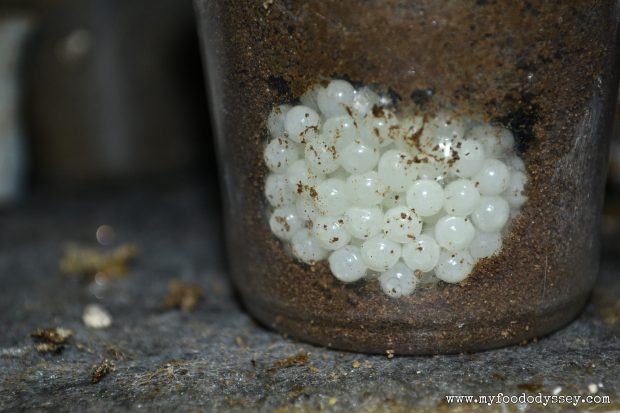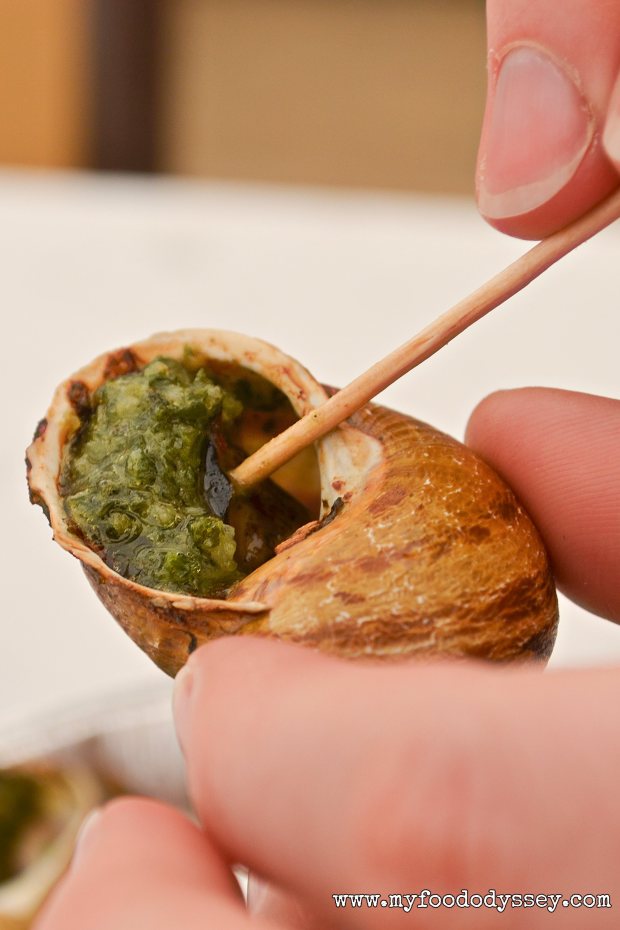Les Escargots (Snails)

I don’t know what I expected a snail farm to look like, but I’m pretty sure this wasn’t it. As we rolled in the gates we could see a small, rustic farmhouse and what looked like a few raised vegetable beds covered with weeds. The drive to the farm had put me in mind of The Wizard of Oz, perhaps due to the long and winding, hedgeless road that disappeared over the horizon, the soporific influence of Enigma on the stereo or the vast fields of yellow rapeseed that lined the road. I knocked on the door and did a slight double-take when a small, well disguised hatch in the door opened and a smiling face appeared. Was I simply dehydrated or had I somehow been transported over the rainbow to Ozcargot?
The owner was an incredibly friendly lady who offered to do the tour partly in French and partly in English for our benefit. “Do you know how to tell the males from the females”, she asked as she held up fat, juicy snail. My eyebrows arched slightly as I imagined that the next piece of information might be quite challenging to my eyesight, considering the size of the snail. Thankfully, it turns out that snails are hermaphrodites, so no demonstration was required.

A golf-ball sized batch of snail eggs buried in the earth.
For her particular breed of snail, the “grand gris” (also called “gros gris”, both meaning “big grey”), mating was achieved by putting their heads together for about 10 hours – quite a romantic notion, really. After this, one of the pair would lay a batch of eggs that would grow as a mass to the size of a golf ball within about 2 hours. The eggs would then incubate in the soil at 20 degrees Celsius for 2 weeks, by which time they would have reached sunlight and be ready to hatch.

The raised beds with darkened slots and lots of greenery, where the snails would mature.
Outside, the raised beds were full of vertical slots of thick, black plastic which provided the darkness and warmth for the snails to sleep during the day. At night they would emerge to feed on cereals and weeds such as nettles and grasses. A gentle plume of water was provided to keep their environment humid. Large nets and fencing buried deep into the ground protected the snails from their natural predators, birds and rodents. The snails would grow happily in this environment for 8 months, when they would reach adulthood and be ready for eating.

Field of rapeseed. But here or somewhere over the rainbow?!
Snails are incredible popular in France, with over 30,000 tons consumed each year. However, many snails are now imported from Eastern Europe as the numbers of snail farms in France continues to dwindle. They are particularly popular around Christmas, where they are eaten as part of a feast with oysters and other shellfish.

I think my own fondness for eating snails is a consequence of the copious quantities of garlic butter in which they are usually drenched. If you gave me a dried dung-beetle (a delicacy somewhere, I’m sure) smothered in that much butter I would probably eat it. We bought a dozen snails fully prepared – we only needed to reheat them gently on our little gas stove. The delectable smell of garlic quickly filled the van and I could hardly wait for the butter to bubble as we had been instructed by our guide. Armed only with a cocktail stick, I tucked in and had almost devoured the lot before I remembered that I had a husband and perhaps should share. Oh, well – we could always put our heads together later to make up for it.
Like what you see? Then please subscribe to My Food Odyssey. For updates on my daily life you can follow me on Facebook, Twitter and Pinterest.
































June, do you know if these snails are the same as the ones we have all over everywhere? I’ve often wondered if ours were edible. Might be an interesting business venture. 🙂
LikeLiked by 1 person
There are two varieties that are reared for eating, Susan – the petit gris and the grand gris (or gros gris). There are lots of other varieties of snails. I reckon you would have to import your starter eggs. That said, there is a huge worldwide shortage, so it’s definitely a good idea for a business venture!
http://www.independent.ie/business/farming/life-in-the-slow-lane-is-just-the-ticket-for-irelands-snail-farmers-34163747.html
LikeLike
Fascinating post! Many years ago I heard a documentary on French radio about snail breeding. I seem to remember that they said that the snails are starved for two weeks before being harvested, apparently to ensure that they don’t taste of soil. Do you know if this is true?
LikeLiked by 1 person
I’m afraid I don’t, Anne, but it doesn’t sound right as I don’t think they eat earth – they eat greens (weeds and grasses). The lady certainly didn’t mention that, but who knows!
LikeLike
Such a cute post!
LikeLiked by 1 person
Reblogged this on My Food Odyssey and commented:
In the next chapter of our food odyssey we reach France and visit a snail farm. It was an interesting afternoon wit a delicious ending!
LikeLike
Hello June,
May I know where this snail farm is located and if there’s any online means of communication with them to ask about there methods of snail breeding?
Thanks.
LikeLiked by 1 person
Hi Bassem. I can’t remember the name of the farm but I have a note of it in my guide book. I’m on holidays at the moment but I’ll post the name and a link if I can find one when I get home, hopefully sometime next week.
LikeLike
Hi Bassem. Apologies for the delay in coming back to you. The name of the farm is L’Escargot du Mont Fossé and it is located in the village of Sommery in Normandy. They don’t appear to have a website but there is some information on the Normandy Tourism website – click here for details. Hope that helps! June.
LikeLike
Oh many thanks for remembering me June :). Will take a look at the link you provided….Thanks
LikeLiked by 1 person
June I love reading your posts your descriptions of food and scenery are very evocative and I can visualize the scenes that said I will never eat snails!!
LikeLike
Thanks Maeve – glad you’re enjoying the posts. I guess snails are a bit like mussels or oysters – they’re just not for everyone!
LikeLike